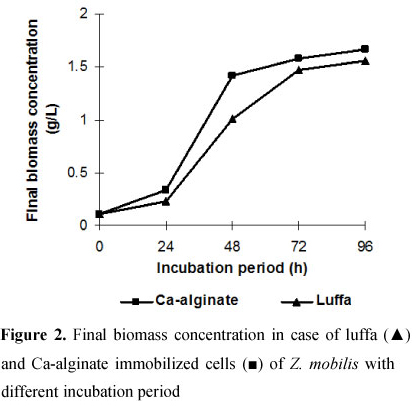Bio-ethanol production from cane molasses (diluted to 15 % sugar w/v) was studied using the bacterium, Zymomonas mobilis MTCC 92 entrapped in luffa (Luffa cylindrica L.) sponge discs and Ca-alginate gel beads as the immobilizing matrices. At the end of 96 h fermentation, the final ethanol concentrations were 58.7 ± 0.09 and 59.1 ± 0.08 g/l molasses with luffa and Ca-alginate entrapped Z. mobilis cells, respectively exhibiting 83.25 ± 0.03 and 84.6 ± 0.02 % sugar conversion. There was no statistical significant difference (Fischer's LSD) in sugar utilization (t = 0.254, p <0.801) and ethanol production (t =-0.663, p <0.513) between the two immobilization matrices used. Further, the immobilized cells in both the matrices were physiologically active for three more cycles of operation with less than 15 % decrease in ethanol yield in the 4th cycle, which was due to some leakage of cells. In conclusion, luffa sponge was found to be equally good as Ca-alginate as a carrier material for bacterial (Z. mobilis. cell immobilization for ethanol production. Further, it has added advantages such as it is cheap, non-corrosive and has no environmental hazard.
Bio-ethanol; Cell immobilization; Fermentation; Molasses; Zymomonas mobilis MTCC 92



